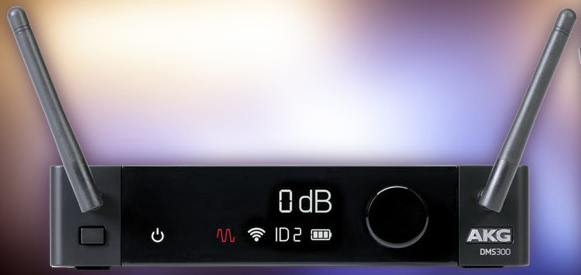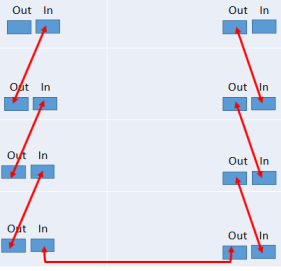DMS100/DMS300 systems are designed for use in small/mid-size venues. Applications include:
Live Sound – for vocal and instrumental musicians
Presentations – for educational/vocational presenters, instructors and trainers
Meeting Spaces – for small/mid-size corporate/business users in need of private, secure wireless communications
DMS100 and DMS300 digital wireless systems are similar in many ways including:
· Easy setup and operation - designed from the ground up to be intuitive with seamless setup, easy channel pairing and adaptive
channel selection that takes the guesswork out of locating available wireless channels.
· Global license free operation – as the available spectrum assigned for use by wireless microphone systems continues to shrink worldwide,
DMS100/DMS300 digital wireless systems are a convenient alternative in that they are able to operate in the 2.4GHz, global license-free wireless space.
· Authentic AKG microphone capsule – The DMS Vocal Sets feature AKG acoustics engineering-designed mic capsules.
· High-resolution 24-bit/48kHz audio quality – pristine vocals and studio quality sound with none of the interference commonly found when
using some analog wireless systems.
· Pro outputs - XLR balance output (0dB line level, -30dB mic level switchable) and ¼" unbalanced line output.
· Advanced AES 256-bit encryption – maintains confidential communications in small-to-medium size meeting spaces.
· 100-foot operating range line. * See section pertaining to single and multiple, simultaneous, co-existing systems use.
· Long battery life - 12-hours handheld or bodypack battery life using 2 x AA alkaline batteries.
· Integration with Soundcraft Ui24R mixing consoles (see details below). · Universal AC/DC power adapter – incorporates cable routing/strain relief on receiver
· DMS100 uses color coded LEDs (green, blue, yellow or purple) for easy channel assignment and identification. Up to four simultaneous,
co-existing DMS100 systems can be used at the same time. The number of systems and operating range may vary based on the complexity/density
of the wireless environment where the system is used.

 X 4
X 4
Bodypack transmitters include an instrument cable that can be used for a wide range of instruments (electric guitars, electric bass, remote keyboards and acoustic instruments that incorporate pickups that have ¼ jack outputs such as acoustic guitar, violin, etc.).
Both DMS100 and DMS300 receivers work with the optional AKG RMU40 Pro rackmount kit.
The bodypack transmitters accept a number of optional 3pin female mini-XLR AKG headsets or clip-on mics:
C111LP
CK77WRLP
CK99L
LC81MD
CM311L
C520L
C555L
C518ML
C519ML
One model NOT recommended is C417L.
The DMS300 offers everything in the DMS100 above plus:
- Seamless setup and operation – supports up to eight simultaneous, co-existing DMS300 systems in use at the same time. The number of systems and operating range may vary based on the complexity/density of the wireless environment where the system is deployed.
- Vivid, high-resolution graphic front-panel LCD screen – easy setup with channel ID number, volume level in dB and bar-style battery indicator displayed.
- Remaining battery level indicator – battery bar indicator on transmitter and receiver displays
- RJ12 jack for sync – coordinates/synchronizes all DMS300 system operation (one foot RJ12 6P6C straight-through cable is included).
It supports longer sync cables up to an 18" maximum length RJ12 6P6C straight-through cable.
- Two removable front-mounted antennas:

MULTIPLE, SIMULTANEOUS, CO-EXISTING DMS100/DMS300 DIGITAL WIRELESS SYSTEM OPERATION
With DMS100, you can support up to a maximum of four simultaneous, co-existing DMS100 systems being used at the same time while DMS300 can support up to a maximum of eight simultaneous, co-existing DMS300 systems being used at the same.
Additionally, a DMS300 is superior to DMS100 in situations when you plan to operate multiple simultaneous, coexisting wireless mic/instrument systems at the same time. DMS300 systems will operate in a coordinated manner that provides frequency management, audio performance and system operation among all systems as long as they are synched using the included RJ12 cable connections as shown below.
Actual operating range and performance may vary based on the wireless environment, congestion, conditions as well as other factors related to line of site operation.
We do not recommended using DMS100 systems at the same time with DMS300 systems or mixing DMS systems with wireless systems from other manufacturers. Doing so may cause a more unstable wireless environment since different systems would be operating in a non-synchronized manner.
Here is a suggested connecting diagram for synchronizing up to a maximum of eight DMS300 systems using seven RJ12 6P6C straight-through wired cables (one RJ12 cable included with each DMS300 system). Supports up to an 18" maximum length RJ12 6P6C straight-through cable.
Diagram example for synchronizing 8 DMS800 receivers using RJ12 cable:


Please note the following when establishing synchronization between multiple DMS300 systems:
Each DMS300 system must be paired first to a unique channel ID number (1-8). You only need to use seven RJ12 6P6C cables to link up to eight systems. If you plan to use seven systems, then you would only need six RJ12 cables, etc. Anytime you plan to use more than one DMS300 at the same time in a small venue location, you must pair each system separately and then sync them using the appropriate 6P6C RJ12 cable(s).
It does not matter what order DMS300 systems are connected to each other. The diagram above shows one possible way to connect them. This diagram provides you with the shortest path for cable routing when units are arranged side-by-side and stacked in this manner.
It does not matter if you power all DMS300 systems ON and then pair each receiver individually to a transmitter or if you power each unit ON individually and then pair each receiver individually to a transmitter.
DMS100 Receiver


Push button ON/OFF power switch
ON/OFF power indicator
Low battery indicator
Audio clipping indicator
RF signal indicator
Channel ID indicator: (DMS100: 4 colors)
9. Control knob modes: a. Volume control – turn the rotary knob to change volume levels b. Pairing mode – press and hold the rotary knob to enter pairing mode
11. Balanced XLR output jack
12. Mic / Line output level switch (pertains to XLR jack only)
13. 1/4 “ Unbalanced line level output jack
15. Power supply strain relief
16. 9VDC jack for power supply


DMS300 Receiver


Push button ON/OFF power switch
ON/OFF power indicator
Low battery indicator
Audio clipping indicator
RF signal indicator
Channel ID indicator: (DMS300: 8 colors)
Remaining battery level indicator
Volume level LCD display
Control knob modes:
a. Volume control – turn the rotary knob to change volume levels
b. Pairing mode – press and hold the rotary knob to enter pairing mode
10. Detachable front antennas x 2pcs
11. Balanced XLR output jack
12. Mic / Line output level switch (pertains to XLR jack only)
13. 1/4“ Unbalanced line level output jack
15. Power supply strain relief
16. 9VDC jack for power supply


DMS100/300 Handheld


ON/OFF Power, Mute, and Low battery Red/Green LED indicator
LCD display (DMS300 only)
ON/OFF Power button and Mute switch
Linking RGB LED indicator (DMS100 Channel ID.RGB LED Color same as receiver)
Pairing channel ID button
2 x AA battery compartment
DMS100/300 Bodypack




ON/OFF Power and Mute button
3-pin Mini XLR input (for instrument or AKG microphones)
ON/OFF Power, Mute, and Low battery Red/Green LED indicator
LCD display showing ID channel number and remaining battery life indicator (DMS300 only)
Gain control trim pot
Pairing channel ID button
2 x AA battery compartment
Beltclip